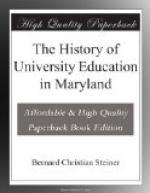The associations or societies serve a different purpose. They bring together larger companies of professors and graduate students, who hear and discuss such papers as the members may present. These papers are not connected by one thread like those which come before the seminaries. They are usually of more general interest, and they often present the results of long continued thought and investigation.
BUILDINGS, LIBRARIES, AND COLLECTIONS.
The site selected when the University was opened in the heart of Baltimore, near the corner of Howard and Monument streets, has proved so convenient, that from time to time additional property in that neighborhood has been secured and the buildings thus purchased have either been modified so as to meet the academic needs, or have given place to new and commodious edifices.
The principal buildings now in use are these:
(1). A central administration building, in which are the class-rooms for classical and oriental studies.
(2). A library building, in which are also rooms devoted especially to history and political science.
(3). A chemical laboratory well equipped for the service of more than a hundred workers.
(4). A biological laboratory, with excellent arrangements for physiological and morphological investigations.
(5). A physical laboratory—the latest and best of the laboratories—with excellent accommodations for physical research and instruction.
(6). A gymnasium for bodily exercise.
(7). Two dwelling houses, appropriated to the collections in mineralogy and geology until a suitable museum and laboratory can be constructed.
(8). Levering Hall, constructed for the uses of the Young Men’s Christian Association, and containing a large hall which may be used for general purpeses.
(9). Smaller buildings used for the smaller classes.
(10). An official residence of the President, which came to the University as a part of the bequest of the late John W. McCoy, Esq.
The library of the university numbers nearly 45,000 well selected volumes,—including “the McCoy library” not yet incorporated with the other books, and numbering 8,000 volumes. Not far from 1,000 periodicals are received, from every part of the civilized world. Quite near to the university is the Library of the Peabody Institute, a large, well-chosen, well-arranged, and well-catalogued collection. It numbers more than one hundred thousand volumes.
The university has extensive collections of minerals and fossils, a select zoological and botanical museum, a valuable collection of ancient coins, a remarkable collection of Egyptian antiquities (formed by Col. Mendes I. Cohen, of Baltimore), a bureau of maps and charts, a number of noteworthy autographs and literary manuscripts of modern date, and a large amount of the latest and best scientific apparatus—astronomical, physical, chemical, biological, photographical, and petrographical.




